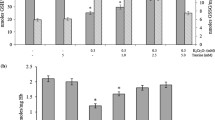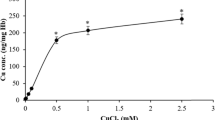Abstract
The effect of potassium dichromate (K2Cr2O7), a hexavalent chromium compound, on human erythrocytes was studied under in vitro conditions. Incubation of erythrocytes with different concentrations of K2Cr2O7 resulted in marked hemolysis in a concentration-dependent manner. K2Cr2O7 treatment also caused significant increase in protein oxidation, lipid peroxidation and decrease in total sulfhydryl content, indicating that it causes oxidative stress in human erythrocytes. However, there was no concomitant nitrosative stress as the nitric oxide levels in hemolysates from K2Cr2O7-treated erythrocytes were lower than in control. Exposure of erythrocytes to K2Cr2O7 decreased the activities of catalase, glutathione peroxidase, thioredoxin reductase, glucose-6-phosphate dehydrogenase, and glutathione reductase, whereas the activities of Cu–Zn superoxide dismutase and glutathione S-transferase were increased. These results show that K2Cr2O7 induces oxidative stress and alters the antioxidant defense mechanism of human erythrocytes.





Similar content being viewed by others
References
Mertz W (1969) Chromium occurrence and function in biological systems. Physiol Rev 49:163–239
Agency for Toxic Substances and Disease Registry (1993) Toxicological Profile for Chromium. Report # ATSDR/TP-92/08. Division of Toxicology/Toxicology Information Branch, Atlanta, GA
Balk EM, Tatsioni A, Lichtenstein AH, Lau J, Pittas AG (2007) Effect of chromium supplementation on glucose metabolism and lipids: a systematic review of randomised controlled trials. Diabetes Care 30:2154–2163
International Agency for Research on Cancer (1990) Chromium, nickel and welding: monographs on the evaluation of carcinogenic risk of chemicals to humans. IARC, Lyon, pp 49–256
Love AHG (1983) Chromium—biological and analytical considerations. In: Burrows D (ed) Chromium: metabolism and toxicity. CRC Press, Boca Raton, pp 1–12
Costa M, Kraker AJ, Patiemo SR (1984) Toxicity and carcinogenicity of essential and non-essential metals. Prog Clin Biochem 1:1–45
Pellerin C, Booker SM (2000) Reflections on hexavalent chromium: health hazards of an industrial heavyweight. Environ Health Perspect 108:402–407
Baruthio F (1992) Toxic effects of chromium and its compounds. Biol Trace Elem Res 32:145–153
Nickens KP, Patierno SR, Ceryak S (2010) Chromium genotoxicity: a double-edged sword. Chem Biol Interact 188:276–288
Standeven AM, Wetterhahn KE (1989) Chromium(VI) toxicity: uptake, reduction, DNA damage. J Am Coll Toxicol 8:1275–1283
Sugiyama M (1994) Role of paramagnetic chromium in chromium(VI)-induced damage in cultured mammalian cells. Environ Health Perspect 102:31–33
Shi XG, Chiu A, Chen CT, Halliwell B, Castranova V, Vallyathan V (1999) Reduction of chromium(VI) and its relationship to carcinogenesis. Toxicol Environ Health 2:87–104
Liu KJ, Shi X (2001) In vivo reduction of chromium(VI) and its related free radical generation. Mol Cell Biochem 222:41–47
Harris GK, Shi X (2003) Signaling by carcinogenic metals and metal induced reactive oxygen species. Mut Res 533:183–200
Sugiyama M (1992) Role of physiological antioxidants in chromium(VI)-induced cellular injury. Free Radic Biol Med 12:397–407
Vasylkiv OY, Kubrak OI, Storey KB, Lushchak VI (2010) Cytotoxicity of chromium ions may be connected with induction of oxidative stress. Chemosphere 80:1044–1049
Bagchi D, Bagchi M, Stohs SJ (2001) Chromium (VI)-induced oxidative stress, apoptotic cell death and modulation of p53 tumor suppressor gene. Mol Cell Biochem 222:149–158
Bagchi D, Stohs SJ, Downs BW, Bagchi M, Preuss HG (2002) Cytotoxicity and oxidative mechanisms of different forms of chromium. Toxicology 180:5–22
Bagchi D, Vuchetich PJ, Bagchi M, Hassoun EA, Tran MX, Tang L, Stohs SJ (1997) Induction of oxidative stress by chronic administration of sodium dichromate [chromium VI] and cadmium chloride [cadmium II] to rats. Free Radic Biol Med 22:471–478
Outridge PM, Scheuhammer AM (1993) Bioaccumulation and toxicology of chromium: implications for wildlife. Rev Environ Contam Toxicol 130:31–77
Lowry OH, Rosebrough NJ, Farr AL, Randall RJ (1951) Protein measurement with the Folin phenol reagent. J Biol Chem 193:265–275
Levine RL, Garland D, Oliver CN, Amici A, Climent I, Lenz AG, Ahn BW, Shaltiel S, Stadtman ER (1990) Determination of carbonyl content in oxidatively modified proteins. Methods Enzymol 186:464–478
Buege JA, Aust SD (1978) Microsomal lipid peroxidation. Methods Enzymol 52:302–308
Sedlak J, Lindsay RH (1968) Estimation of total, protein-bound and nonprotein sulphydryl groups in tissue with Ellman’s reagent. Anal Biochem 25:192–205
Miranda KM, Espey MG, Wink DA (2001) A rapid, simple spectrophotometric method for simultaneous detection of nitrate and nitrite. Nitric Oxide 5:62–71
Marklund S, Marklund G (1974) Involvement of the superoxide anion radical in the autooxidation of pyrogallol and a convenient assay for superoxide dismutase. Eur J Biochem 47:469–474
Aebi H (1984) Catalase in vitro. Methods Enzymol 105:121–126
Shonk CC, Boxer GE (1964) Enzyme patterns in human tissues. I. Methods for the determination of glycolytic enzymes. Cancer Res 24:709–721
Carlberg I, Mannervik B (1985) Glutathione reductase. Methods Enzymol 113:484–490
Habig WH, Pabst MJ, Jokoby WB (1974) Glutathione S-transferases. The first enzymatic step in mercapturic acid formation. J Biol Chem 249:130–139
Tamura T, Stadtman TC (1996) A new selenoprotein from human lung adenocarcinoma cells: purification, properties and thioredoxin reductase activity. Proc Natl Acad Sci USA 93:1006–1011
Flohe L, Gunzler WA (1984) Assays of glutathione peroxidase. Methods Enzymol 105:114–121
Cohen MD, Kargacin B, Klein CB, Costa M (1993) Mechanisms of chromium carcinogenicity and toxicity. Crit Rev Toxicol 23:255–281
Vonburg R, Liu D (1993) Chromium and hexavalent chromium. J Appl Toxicol 13:225–230
Wiegand HJ, Ottenwalder H, Bolt HM (1985) Fast uptake kinetics in vitro of Cr(VI) by red blood cells of man and rat. Arch Toxicol 57:31–34
Debetto P, Luciani S (1988) The toxic effect of chromium on cellular metabolism. Sci Total Environ 71:365–377
Stout MD, Herbert RA, Kissling GE et al (2009) Hexavalent chromium is carcinogenic to F344/N rats and B6C3F1 mice after chronic oral exposure. Environ Health Perspect 117:716–722
Peerzada CJ, Yam CP, Chirino YI, Sánchez GDJ, Martínez MCM, Cruz C, Medina CON (2008) Protective effects of garlic powder against potassium dichromate-induced oxidative stress and nephrotoxicity. Food Chem Toxicol 46:619–627
Travacio M, Polo JM, Liesuy S (2001) Chromium(VI) induces oxidative stress in the mouse brain. Toxicology 162:139–148
Arivarasu NA, Fatima S, Mahmmod R (2008) Oral administration of potassium dichromate inhibits brush border membrane enzymes and alters anti-oxidant status of rat intestine. Arch Toxicol 12:951–958
Radi R (2004) Nitric oxide, oxidants, and protein tyrosine nitration. Proc Natl Acad Sci USA 101:4003–4008
Steinhagen D, Helmus T, Maurer S, Michael RD, Leibold W, Scharsack JP et al (2004) Effect of hexavalent carcinogenic chromium on carp Cyprinus carpio immune cells. Dis Aquat Organ 62:155–161
Pedraza-Chaverrí J, Barrera D, Medina-Campos ON, Carvajal RC, Hernández-Pando R, Macías-Ruvalcaba NA et al (2005) Time course study of oxidative and nitrosative stress and antioxidant enzymes in K2Cr2O7-induced nephrotoxicity. BMC Nephrol 6:4
Grotto D, de Castro MM, Barcelos GR, Garcia SC, Barbosa F Jr (2009) Low level and sub-chronic exposure to methylmercury induces hypertension in rats: nitric oxide depletion and oxidative damage as possible mechanisms. Arch Toxicol 83:653–662
Park HJ, Kim JY, Kim J, Lee JH, Hahn JS, Gu MB, Yoon J (2009) Silver-ion-mediated reactive oxygen species generation affecting bactericidal activity. Water Res 43:1027–1032
Sopjani M, Föller M, Haendeler J, Götz F, Lang F (2009) Silver ion-induced suicidal erythrocyte death. J Appl Toxicol 29:531–536
Forman HJ, Boveris A (1982) Superoxide radical and hydrogen peroxide in mitochondria. In: Pryor WA (ed) Free radicals in biology. Academic, New York, pp 65–90
Arner ESJ, Holmgren A (2000) Physiological functions of thioredoxin and thioredoxin reductase. Eur J Biochem 267:6102–6109
Author information
Authors and Affiliations
Corresponding author
Rights and permissions
About this article
Cite this article
Ahmad, M.K., Syma, S. & Mahmood, R. Cr(VI) Induces Lipid Peroxidation, Protein Oxidation and Alters the Activities of Antioxidant Enzymes in Human Erythrocytes. Biol Trace Elem Res 144, 426–435 (2011). https://doi.org/10.1007/s12011-011-9119-5
Received:
Accepted:
Published:
Issue Date:
DOI: https://doi.org/10.1007/s12011-011-9119-5




